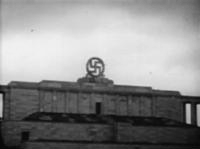Heartland Theory
This article contains too many or overly lengthy quotations .(July 2022) |
Hitler's plan for world domination is described in terms of Halford Mackinder's Heartland Theory, which starts about three minutes into the film:
In the Middle Ages a plague of slavery descended on the world. From the wilds of Mongolia rode a mighty army of fierce horsemen, led by Genghis Khan. Burning, looting, pillaging... the barbarian horde swept across Asia and Eastern Europe. Genghis Khan controlled most of the world of the thirteenth century. Adolf Hitler was determined to outdo him, and conquer all the world of the twentieth century.
Set up at Munich was an institute devoted to the little-known science of geopolitics, vaguely defined as "the military control of space". Germany's leading geopolitician, a former general, Karl Haushofer, was head man. He has gathered together more information about your home town than you yourself know.
To the German geopolitician, the world is not made up of men and women and children, who live and love and dream of better things. It is made up of only two elements – labor and raw materials. The geopoliticians' job was to transform Hitler's ambition to control these elements into cold, hard reality.
On their map our planet is neatly divided into land and water. Water forms three quarters of the Earth's surface, land only one quarter. And in that one quarter of the Earth's surface lies the world's wealth, all its natural resources – and the world's manpower.
Control the land and you control the world – that was Hitler's theory. This all-important "land" the geopoliticians now break up into two areas – one the Western Hemisphere, which together with Australia and all the islands of the world including Japan, comprises one third of the total land area. The other area, which consists of Europe, Asia, and Africa, makes up the other two thirds. This supercontinent, which they call the "World Island", is not only twice as large as the rest of the land area, but also includes seven eighths of the world's population.
The heart of this "World Island" comprises Eastern Europe and most of Asia. This they call the "Heartland", which just about coincides with the old empire of Genghis Khan.
Hitler's step-by-step plan for world conquest can be summarized this way:
Conquer Eastern Europe and you dominate the Heartland.
Conquer the Heartland and you dominate the World Island.
Conquer the World Island... and you dominate the World.That was the dream in Hitler's mind as he stood at Nuremberg.
